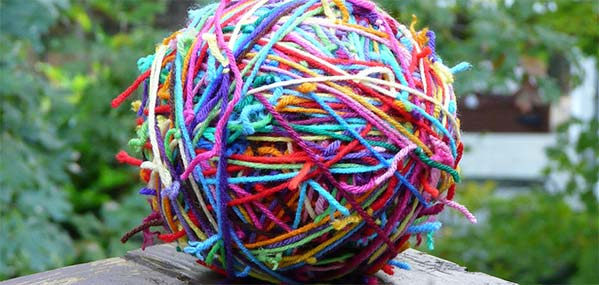This post carries on the introduction to the recapitulation theories that were framed by Irenaeus (130-202). Irenaeus was taught by Polycarp, who in turn heard sermons preached by a certain John the Evangelist. Imagine what that must have been like – to meet first generation apostle – someone who knew Jesus the man? So, we are right back almost at the source.
When I was at school I read Shakespeare and Chaucer; perhaps I should say I was ‘forced to read’ Shakespeare and Chaucer. To be honest, I did not understand much of school, and English Literature classes were some of the most boring of all! (ha ha, the irony!) I could read the words of these old books no problem, but put the words together and they didn’t mean much to me.

It’s all Greek to me…
The same is true when you first start reading the saints of the early church. It feels like you are reading biblical Greek – which i don’t. The meaning seems hard to grasp, and the language goes round in knots, like a ball of tangled wool, leaving you with a sense of what it means, but not a full grasp. You can get frustrated untangling the wool, and sometimes its best to just leave it for a while. The same is true reading the Saints – you have to sit with them. However, it is well worth the struggle.
We ended up the last post saying that Irenaeus based his theories on the concept of the first and last Adam that Paul talks about in in 1 Cor 15. We saw that God gathered together in ‘Himself the ancient formation of man and woman’ in order to ‘kill sin, deprive death of its power and vivify humanity’.[1] So Jesus is indeed the archetypal human, just as Adam and Eve were. In him is everything they were meant to be and become as God’s imagers. But how does this work? Thankfully Irenaeus has something to say about this too.
For by no other means could we have attained to incorruptibility and immortality, unless we had been united to incorruptibility and immortality. But how could we be joined to incorruptibility and immortality, unless, first, incorruptibility and immortality had become that which we also are, so that the corruptible might be swallowed up by incorruptibility, and the mortal by immortality, that we might receive the adoption of sons and daughters? [2]
Time to Untangle
Time to get untangling…. In life group we broke this down phrase by phrase to get to grips with it. Let’s do the same here.
For by no other means could we have attained to incorruptibility and immortality …
Something that is incorruptible is not subject to decay, one result of the fall, and something we spend our lives fighting with.[3] Our possessions decay. Our bodies decay. You get the picture. Here Irenaeus is laying out the problem which is that we have got decay in our lives, and there is no way that we can escape it and recapture the glorious immortality and perfection that we were designed to have, and to live with. He continues:
…unless we had been united to incorruptibility and immortality…
Irenaeus says that if we can be joined to immortality in some way we will inherit that immortality. The same is true of incorruptibility. The answer to how we can be restored to what we were intended to be is that we must be joined, or united with those properties that we have lost.
But how could we be joined to incorruptibility and immortality, unless, first, incorruptibility and immortality had become that which we also are…
This point is the heart of the matter. According tot he Fathers we cannot simply be joined to God because he is of a totally different makeup to us. He is uncreated, infinite and so on. We are created, limited. It is like trying to join light and dark -you end up with light. God has these qualities that we have lost. We cannot be joined to him and therefore reclaim those properties. So the solution was that God had to become like we are – subject to decay (think of it!) and mortal. Fully human. Here we see the pivotal place of the incarnation in this model of atonement.
… so that the corruptible might be swallowed up by incorruptibility, and the mortal by immortality, that we might receive the adoption of sons and daughters?
Through becoming as we are, but still being fully God Jesus has united that which does not decay with that which does, that which dies with that which cannot. We are now adopted. We now can have that which was lost, and the image can once again reflect the divine image. We can participate in the Godhead. Awesome. More than awesome. Astounding.
Light Swallows up the Darkness
Irenaeus sees here the unlimited power of God. The divine qualities swallow up those that are not of the same quality. Again, light dispels darkness not the other way around. This is a challenge to us to not fall for the idea that the cosmic battle we were talking about is between two equal sides. The Saints teach something very different. God is so far above and beyond that his divine qualities literally extinguishes the the evil. It very much isn’t a fair fight! It is what theologians describe as ‘contagious holiness’.[4]
There is clearly a lot more that could be written. At some point it would be helpful to look at what such churches as the Eastern Orthodox believe about atonement. My understanding is that Irenaeus recapitulation theory was developed but still underpins ideas of participation in the divine nature which is at the root of mystical Christianity.
References etc
- Irenaeus, Against Heresies, Book 3, Chapter 18, para 18. http://www.newadvent.org/fathers/0103318.htm Accessed 07102019
- Irenaeus, Against Heresies, 3,19,1. http://www.newadvent.org/fathers/0103319.htm Accessed 10/10/2019
- There is something here too about not being turned from what you know is right.
- Contagious holiness was one of the most freeing and exciting ideas I came across during my theological study. It has the potential to help untangle many balls of wool.



